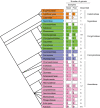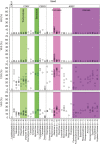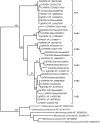Palm seed and fruit lipid composition: phylogenetic and ecological perspectives
- PMID: 31665224
- PMCID: PMC7080222
- DOI: 10.1093/aob/mcz175
Palm seed and fruit lipid composition: phylogenetic and ecological perspectives
Abstract
Background and aims: Palms are vital to worldwide human nutrition, in particular as major sources of vegetable oils. However, our knowledge of seed and fruit lipid diversity in the family Arecaceae is limited. We therefore aimed to explore relationships between seed and fruit lipid content, fatty acid composition in the respective tissues, phylogenetic factors and biogeographical parameters.
Methods: Oil content and fatty acid composition were characterized in seeds and fruits of 174 and 144 palm species respectively. Distribution, linear regression and multivariate analyses allowed an evaluation of the chemotaxonomic value of these traits and their potential relationship with ecological factors.
Key results: A considerable intra-family diversity for lipid traits was revealed. Species with the most lipid-rich seeds belonged to the tribe Cocoseae, while species accumulating oil in the mesocarp occurred in all subfamilies and two-thirds of the tribes studied. Seed and fruit lipid contents were not correlated. Fatty acid composition of mesocarp oil was highly variable within tribes. By contrast, within-tribe diversity for seed lipid traits was low, whereas between-tribe variability was high. Consequently, multivariate analyses of seed lipid traits produced groupings of species belonging to the same tribe. Medium-chain fatty acids predominated in seeds of most palm species, but they were also accumulated in the mesocarp in some cases. Seed unsaturated fatty acid content correlated with temperature at the coldest latitude of natural occurrence.
Conclusion: Several previously uncharacterized palms were identified as potential new sources of vegetable oils for comestible or non-food use. Seed lipid traits reflect genetic drift that occurred during the radiation of the family and therefore are highly relevant to palm chemotaxonomy. Our data also suggest that seed unsaturated fatty acids may provide an adaptive advantage in the coldest environments colonized by palms by maintaining storage lipids in liquid form for efficient mobilization during germination.
Keywords: Arecaceae; chemotaxonomy; ecology; endosperm; fatty acid composition; fruit; lipid content; mesocarp; oil; phylogeny; seed.
© The Author(s) 2019. Published by Oxford University Press on behalf of the Annals of Botany Company. All rights reserved. For permissions, please e-mail: journals.permissions@oup.com.
Figures










References
-
- de Abreu e Lima F, Li K, Wen W, et al. . 2018. Unraveling lipid metabolism in maize with time-resolved multi-omics data. Plant Journal 93: 1102–1115. - PubMed
-
- Acevedo-Quintero JF, Zamora-Abrego JG. 2016. Role of mammals on seed dispersal and predation processes of Mauritia flexuosa (Arecaceae) in the Colombian Amazon. International Journal of Tropical Biology 64: 5–15. - PubMed
-
- Aitzetmüller K. 1993. Capillary GLC fatty acid fingerprints of seed lipids – a tool in plant chemotaxonomy? Journal of High Resolution Chromatography 16: 488–490.
-
- Aitzetmüller K, Tsevegsüren N. 1994. Seed fatty acids, «front-end»-desaturases and chemotaxonomy – a case study in the Ranunculaceae. Journal of Plant Physiology 143: 538–543.
-
- Aitzetmüller K, Matthäus B, Friedrich H. 2003. A new database for seed oil fatty acids – the database SOFA. European Journal of Lipid Science and Technology 105: 92–103.
Publication types
MeSH terms
Substances
LinkOut - more resources
Full Text Sources

